CCNA 2 v7.0 Final Exam Answers Full – Switching, Routing and Wireless Essentials
CCNA 2 v7 Final Exam Answers
1. Refer to the exhibit. What will router R1 do with a packet that has a destination IPv6 address of 2001:db8:cafe:5::1?
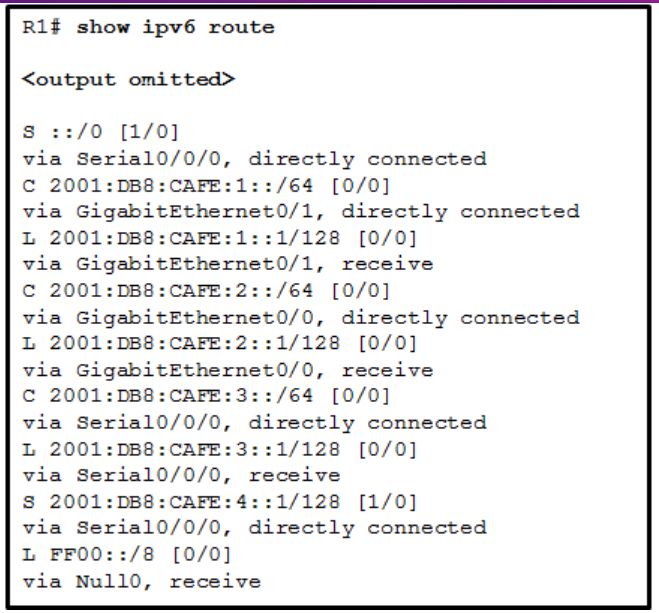
CCNA 2 v7 Switching Routing and Wireless Essentials-Version 7.00-Final-Answers-1
- forward the packet out GigabitEthernet0/0
- drop the packet
- forward the packet out GigabitEthernet0/1
- forward the packet out Serial0/0/0
2. Refer to the exhibit. Currently router R1 uses an EIGRP route learned from Branch2 to reach the 10.10.0.0/16 network. Which floating static route would create a backup route to the 10.10.0.0/16 network in the event that the link between R1 and Branch2 goes down?
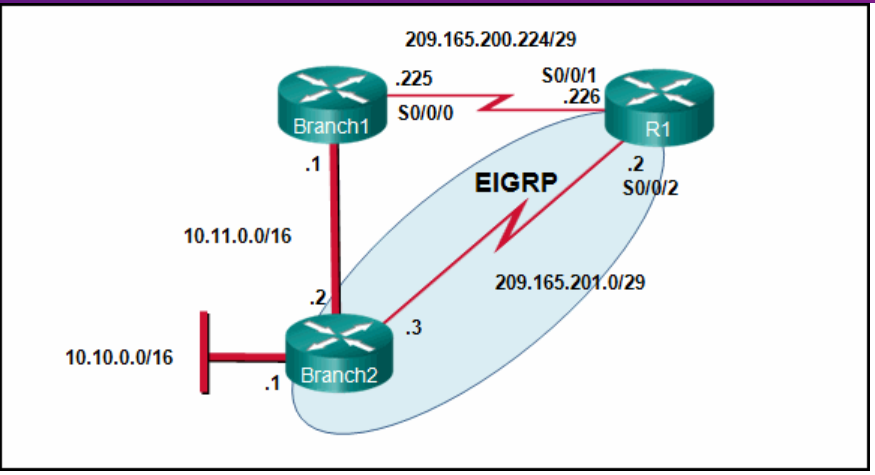
CCNA 2 v7 Switching Routing and Wireless Essentials-Version-Final-Answers-2
- ip route 10.10.0.0 255.255.0.0 Serial 0/0/0 100
- ip route 10.10.0.0 255.255.0.0 209.165.200.226 100
- ip route 10.10.0.0 255.255.0.0 209.165.200.225 100
- ip route 10.10.0.0 255.255.0.0 209.165.200.225 50
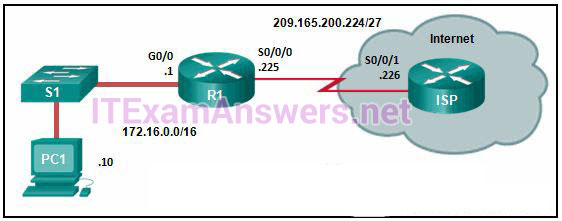
CCNA 2 v7 Switching Routing and Wireless Essentials-Version-Final-Answers-3
3. Refer to the exhibit. R1 was configured with the static route command ip route 209.165.200.224 255.255.255.224 S0/0/0 and consequently users on network 172.16.0.0/16 are unable to reach resources on the Internet. How should this static route be changed to allow user traffic from the LAN to reach the Internet?
- Add an administrative distance of 254.
- Change the destination network and mask to 0.0.0.0 0.0.0.0
- Change the exit interface to S0/0/1.
- Add the next-hop neighbor address of 209.165.200.226.
4. Which option shows a correctly configured IPv4 default static route?
- ip route 0.0.0.0 255.255.255.0 S0/0/0
- ip route 0.0.0.0 0.0.0.0 S0/0/0
- ip route 0.0.0.0 255.255.255.255 S0/0/0
- ip route 0.0.0.0 255.0.0.0 S0/0/0
5. Refer to the exhibit. Which static route command can be entered on R1 to forward traffic to the LAN connected to R2?
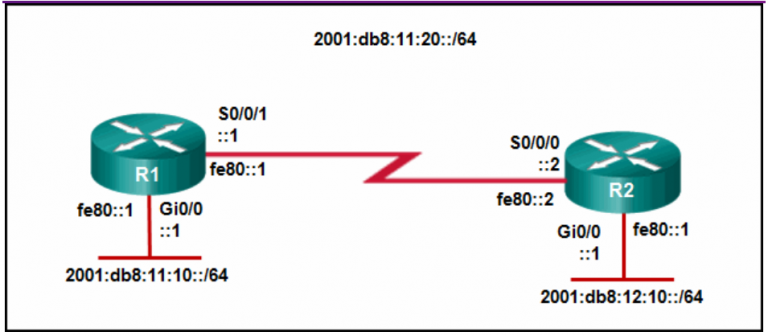
CCNA 2 v7 Switching Routing and Wireless Essentials-Version-Final-Answers-5
- ipv6 route 2001:db8:12:10::/64 S0/0/0
- ipv6 route 2001:db8:12:10::/64 S0/0/1 fe80::2
- ipv6 route 2001:db8:12:10::/64 S0/0/0 fe80::2
- ipv6 route 2001:db8:12:10::/64 S0/0/1 2001:db8:12:10::1
6. What is a method to launch a VLAN hopping attack?
- introducing a rogue switch and enabling trunking
- sending spoofed native VLAN information
- sending spoofed IP addresses from the attacking host
- flooding the switch with MAC addresses
7. A cybersecurity analyst is using the macof tool to evaluate configurations of switches deployed in the backbone network of an organization. Which type of LAN attack is the analyst targeting during this evaluation?
- VLAN hopping
- DHCP spoofing
- MAC address table overflow
- VLAN double-tagging
8. A new Layer 3 switch is connected to a router and is being configured for interVLAN routing. What are three of the five steps required for the configuration? (Choose three.)
- assigning the ports to the native VLAN
- modifying the default VLAN
- creating SVI interfaces
- adjusting the route metric
- enabling IP routing
- assigning ports to VLANs
- installing a static route
9. Refer to the exhibit. A network administrator configured routers R1 and R2 as part of HSRP group 1. After the routers have been reloaded, a user on Host1 complained of lack of connectivity to the Internet The network administrator issued the show standby brief command on both routers to verify the HSRP operations. In addition, the administrator observed the ARP table on Host1. Which entry should be seen in the ARP table on Host1 in order to gain connectivity to the Internet?

CCNA 2 v7 Switching Routing and Wireless Essentials-Version-Final-Answers-9
- the virtual IP address and the virtual MAC address for the HSRP group 1
- the virtual IP address of the HSRP group 1 and the MAC address of R1
- the virtual IP address of the HSRP group 1 and the MAC address of R2
10. Match the forwarding characteristic to its type. (Not all options are used.)
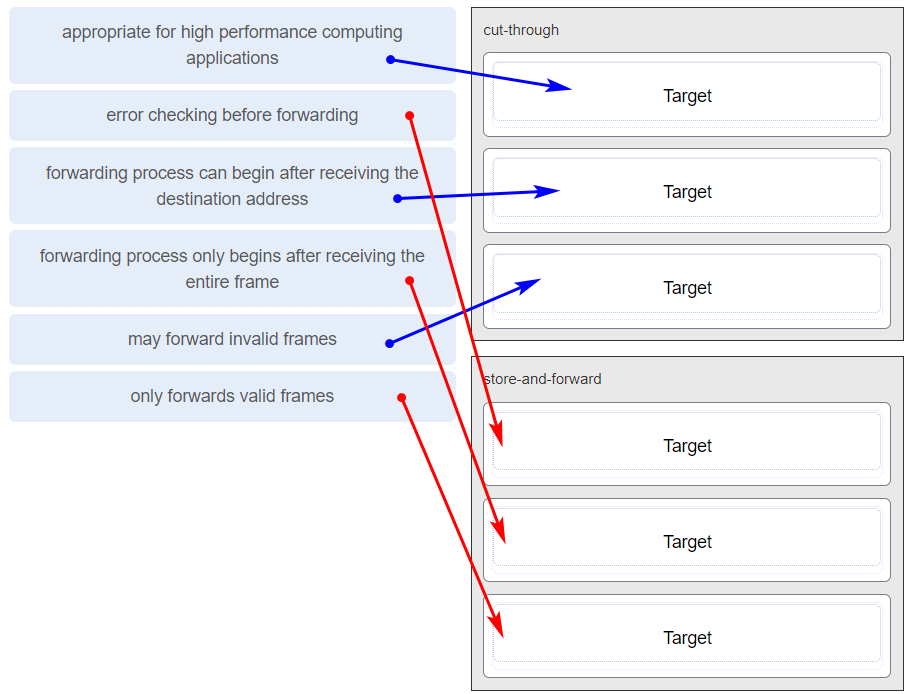

11. Which statement is correct about how a Layer 2 switch determines how to forward frames?
- Frame forwarding decisions are based on MAC address and port mappings in the CAM table.
- Only frames with a broadcast destination address are forwarded out all active switch ports.
- Cut-through frame forwarding ensures that invalid frames are always dropped.
12. Which statement describes a result after multiple Cisco LAN switches are interconnected?
- The broadcast domain expands to all switches.
- One collision domain exists per switch.
- There is one broadcast domain and one collision domain per switch.
- Frame collisions increase on the segments connecting the switches.
- Unicast frames are always forwarded regardless of the destination MAC address.
13. Match the link state to the interface and protocol status. (Not all options are used.)
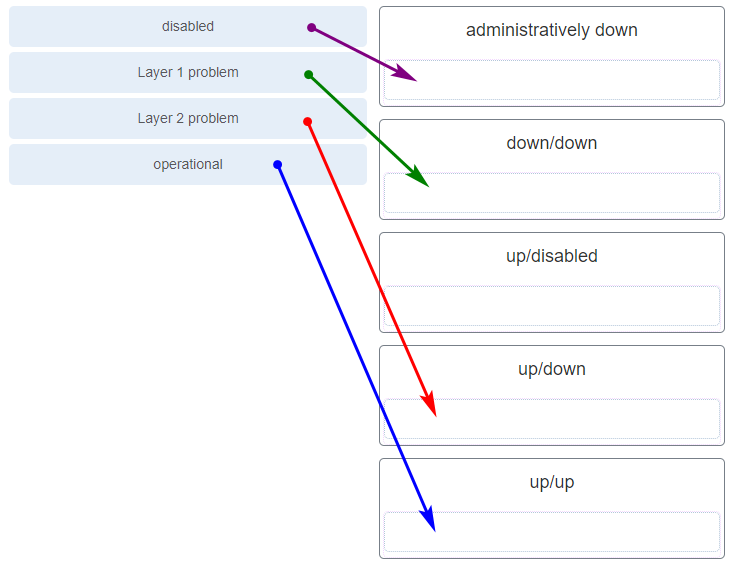

14.Refer to the exhibit. How is a frame sent from PCA forwarded to PCC if the MAC address table on switch SW1 is empty?
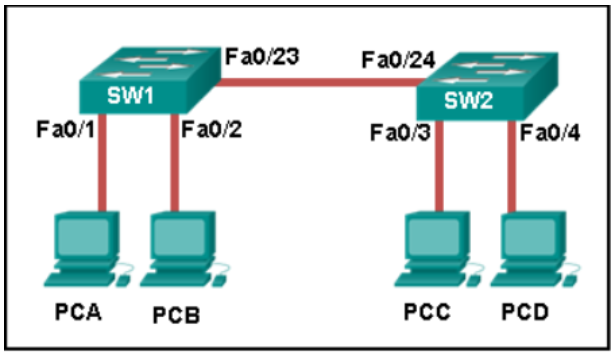
CCNA 2 v7 Switching Routing and Wireless Essentials-Version-Final-Answers-14
- SW1 forwards the frame directly to SW2. SW2 floods the frame to all ports connected to SW2, excluding the port through which the frame entered the switch.
- SW1 floods the frame on all ports on the switch, excluding the interconnected port to switch SW2 and the port through which the frame entered the switch.
- SW1 floods the frame on all ports on SW1, excluding the port through which the frame entered the switch.
- SW1 drops the frame because it does not know the destination MAC address.
15. An administrator is trying to remove configurations from a switch. After using the command erase startup-config and reloading the switch, the administrator finds that VLANs 10 and 100 still exist on the switch. Why were these VLANs not removed?
- Because these VLANs are stored in a file that is called vlan.dat that is located in flash memory, this file must be manually deleted.
- These VLANs cannot be deleted unless the switch is in VTP client mode.
- These VLANs are default VLANs that cannot be removed.
- These VLANs can only be removed from the switch by using the no vlan 10 and no vlan 100 commands.
16. Match the description to the correct VLAN type. (Not all options are used.)
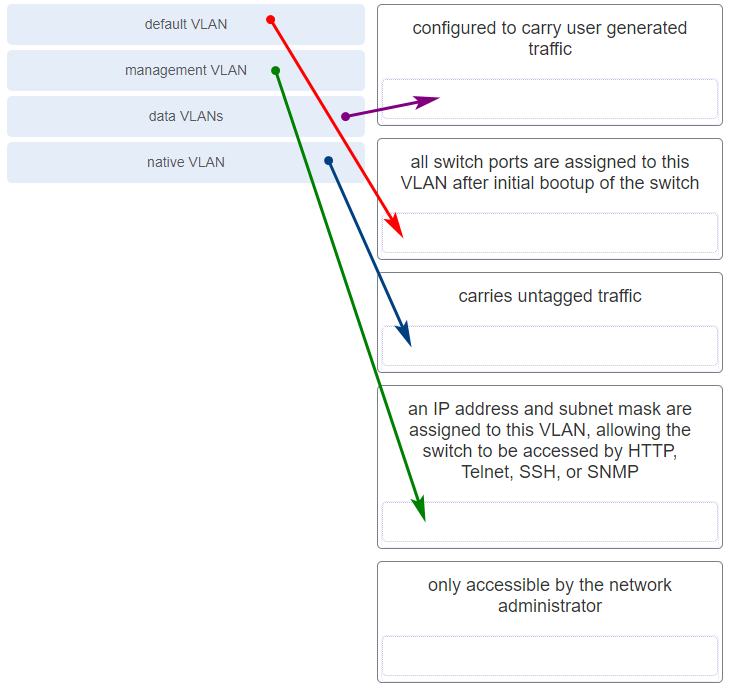
CCNA-2-v7-final-exam-answers-16
17. Refer to the exhibit. A network administrator has connected two switches together using EtherChannel technology. If STP is running, what will be the end result?

CCNA 2 v7 Switching Routing and Wireless Essentials-Version-Final-Answers-17
- STP will block one of the redundant links.
- The switches will load balance and utilize both EtherChannels to forward packets.
- The resulting loop will create a broadcast storm.
- Both port channels will shutdown.
18. What is a secure configuration option for remote access to a network device?
- Configure an ACL and apply it to the VTY lines.
- Configure 802.1x.
- Configure SSH.
- Configure Telnet.
19. Which wireless encryption method is the most secure?
- WPA2 with AES
- WPA2 with TKIP
- WEP
- WPA
20. After attaching four PCs to the switch ports, configuring the SSID and setting authentication properties for a small office network, a technician successfully tests the connectivity of all PCs that are connected to the switch and WLAN. A firewall is then configured on the device prior to connecting it to the Internet. What type of network device includes all of the described features?
- firewall appliance
- wireless router
- switch
- standalone wireless access point
21. Refer to the exhibit. Host A has sent a packet to host B. What will be the source MAC and IP addresses on the packet when it arrives at host B?

CCNA 2 v7 Switching Routing and Wireless Essentials-Version-Final-Answers-21
- Source MAC: 00E0.FE91.7799
Source IP: 10.1.1.10 - Source MAC: 00E0.FE10.17A3
Source IP: 10.1.1.10 - Source MAC: 00E0.FE10.17A3
Source IP: 192.168.1.1 - Source MAC: 00E0.FE91.7799
Source IP: 10.1.1.1 - Source MAC: 00E0.FE91.7799
Source IP: 192.168.1.1
22. Refer to the exhibit. Which static route would an IT technician enter to create a backup route to the 172.16.1.0 network that is only used if the primary RIP learned route fails?
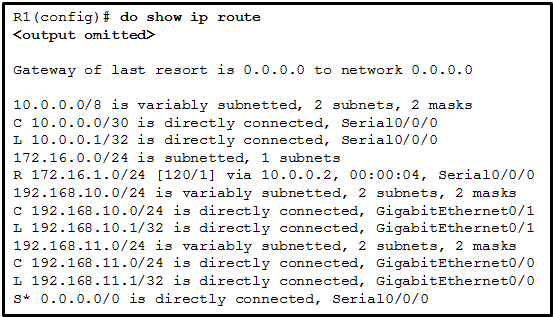
CCNA 2 v7 Switching Routing and Wireless Essentials-Version-Final-Answers-22
- ip route 172.16.1.0 255.255.255.0 s0/0/0
- ip route 172.16.1.0 255.255.255.0 s0/0/0 91
- ip route 172.16.1.0 255.255.255.0 s0/0/0 121
- ip route 172.16.1.0 255.255.255.0 s0/0/0 111
23. Refer to the exhibit. In addition to static routes directing traffic to networks 10.10.0.0/16 and 10.20.0.0/16, Router HQ is also configured with the following command:
ip route 0.0.0.0 0.0.0.0 serial 0/1/1
What is the purpose of this command?
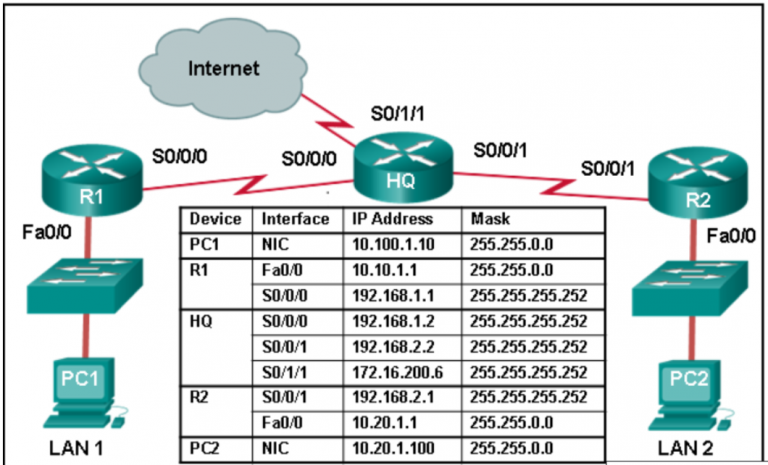
CCNA 2 v7 Switching Routing and Wireless Essentials-Version-Final-Answers-23

- Packets that are received from the Internet will be forwarded to one of the LANs connected to R1 or R2.
- Packets with a destination network that is not 10.10.0.0/16 or is not 10.20.0.0/16 or is not a directly connected network will be forwarded to the Internet.
- Packets from the 10.10.0.0/16 network will be forwarded to network 10.20.0.0/16, and packets from the 10.20.0.0/16 network will be forwarded to network 10.10.0.0/16.
- Packets that are destined for networks that are not in the routing table of HQ will be dropped.
24. What protocol or technology disables redundant paths to eliminate Layer 2 loops?
- VTP
- STP
- EtherChannel
- DTP
25. Refer to the exhibit. Based on the exhibited configuration and output, why is VLAN 99 missing?
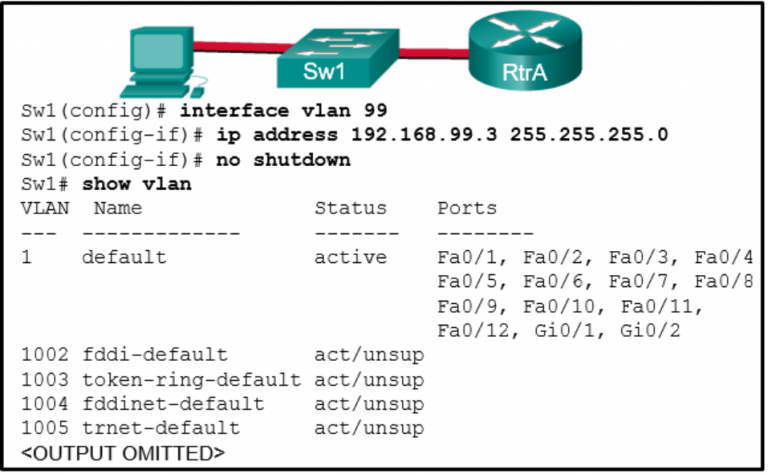
CCNA 2 v7 Switching Routing and Wireless Essentials-Version-Final-Answers-25
- because VLAN 99 is not a valid management VLAN
- because there is a cabling problem on VLAN 99
- because VLAN 1 is up and there can only be one management VLAN on the switch
- because VLAN 99 has not yet been created
26. Which two VTP modes allow for the creation, modification, and deletion of VLANs on the local switch? (Choose two.)
- client
- master
- distribution
- slave
- server
- transparent
27. Which three steps should be taken before moving a Cisco switch to a new VTP management domain? (Choose three.)
- Configure the switch with the name of the new management domain.
- Reset the VTP counters to allow the switch to synchronize with the other switches in the domain.
- Configure the VTP server in the domain to recognize the BID of the new switch.
- Download the VTP database from the VTP server in the new domain.
- Select the correct VTP mode and version.
- Reboot the switch.
28. A network administrator is preparing the implementation of Rapid PVST+ on a production network. How are the Rapid PVST+ link types determined on the switch interfaces?
- Link types can only be configured on access ports configured with a single VLAN.
- Link types can only be determined if PortFast has been configured.
- Link types are determined automatically.
- Link types must be configured with specific port configuration commands.
29. Refer to the exhibit. All the displayed switches are Cisco 2960 switches with the same default priority and operating at the same bandwidth. Which three ports will be STP designated ports? (Choose three.)
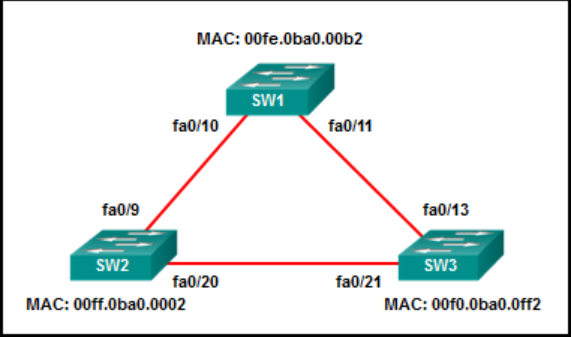
CCNA 2 v7 Switching Routing and Wireless Essentials-Version-Final-Answers-29
- fa0/9
- fa0/13
- fa0/10
- fa0/20
- fa0/21
- fa0/11
30. How will a router handle static routing differently if Cisco Express Forwarding is disabled?
- It will not perform recursive lookups.
- Ethernet multiaccess interfaces will require fully specified static routes to avoid routing inconsistencies.
- Static routes that use an exit interface will be unnecessary.
- Serial point-to-point interfaces will require fully specified static routes to avoid routing inconsistencies.
31. Compared with dynamic routes, what are two advantages of using static routes on a router? (Choose two.)
- They improve network security.
- They take less time to converge when the network topology changes.
- They improve the efficiency of discovering neighboring networks.
- They use fewer router resources.
32. Refer to the exhibit. Which route was configured as a static route to a specific network using the next-hop address?
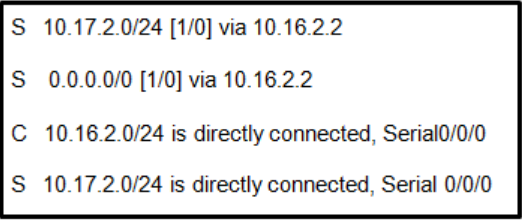
CCNA 2 v7 Switching Routing and Wireless Essentials-Version-Final-Answers-32
- S 10.17.2.0/24 [1/0] via 10.16.2.2
- S 0.0.0.0/0 [1/0] via 10.16.2.2
- S 10.17.2.0/24 is directly connected, Serial 0/0/0
- C 10.16.2.0/24 is directly connected, Serial0/0/0
33. What is the effect of entering the spanning-tree portfast configuration command on a switch?
- It disables an unused port.
- It disables all trunk ports.
- It enables portfast on a specific switch interface.
- It checks the source L2 address in the Ethernet header against the sender L2 address in the ARP body.
34. What is the IPv6 prefix that is used for link-local addresses?
- FF01::/8
- 2001::/3
- FC00::/7
- FE80::/10
35. Which two statements are characteristics of routed ports on a multilayer switch? (Choose two.)
- In a switched network, they are mostly configured between switches at the core and distribution layers.
- The interface vlan command has to be entered to create a VLAN on routed ports.
- They support subinterfaces, like interfaces on the Cisco IOS routers.
- They are used for point-to-multipoint links.
- They are not associated with a particular VLAN.
36. Successful inter-VLAN routing has been operating on a network with multiple VLANs across multiple switches for some time. When an inter-switch trunk link fails and Spanning Tree Protocol brings up a backup trunk link, it is reported that hosts on two VLANs can access some, but not all the network resources that could be accessed previously. Hosts on all other VLANS do not have this problem. What is the most likely cause of this problem?
- The protected edge port function on the backup trunk interfaces has been disabled.
- The allowed VLANs on the backup link were not configured correctly.
- Dynamic Trunking Protocol on the link has failed.
- Inter-VLAN routing also failed when the trunk link failed.
37. Which command will start the process to bundle two physical interfaces to create an EtherChannel group via LACP?
- interface port-channel 2
- channel-group 1 mode desirable
- interface range GigabitEthernet 0/4 – 5
- channel-group 2 mode auto
38. What action takes place when a frame entering a switch has a multicast destination MAC address?
- The switch will forward the frame out all ports except the incoming port.
- The switch forwards the frame out of the specified port.
- The switch adds a MAC address table entry mapping for the destination MAC address and the ingress port.
- The switch replaces the old entry and uses the more current port.
39. A junior technician was adding a route to a LAN router. A traceroute to a device on the new network revealed a wrong path and unreachable status. What should be done or checked?
- Verify that there is not a default route in any of the edge router routing tables.
- Check the configuration on the floating static route and adjust the AD.
- Create a floating static route to that network.
- Check the configuration of the exit interface on the new static route.
40. Select the three PAgP channel establishment modes. (Choose three.)
- auto
- default
- passive
- desirable
- extended
- on
41. A static route has been configured on a router. However, the destination network no longer exists. What should an administrator do to remove the static route from the routing table?
- Remove the route using the no ip route command.
- Change the administrative distance for that route.
- Change the routing metric for that route.
- Nothing. The static route will go away on its own.
42. Refer to the exhibit. What can be concluded about the configuration shown on R1?
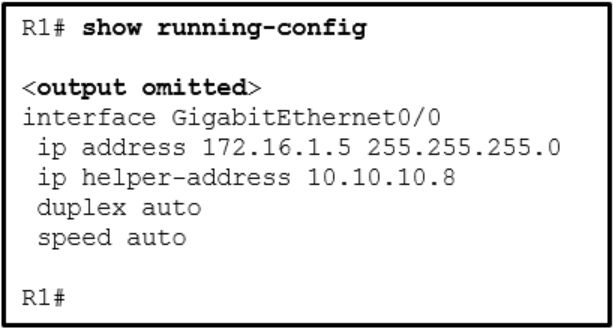
CCNA 2 v7 Switching Routing and Wireless Essentials-Version-Final-Answers-42
- R1 is configured as a DHCPv4 relay agent.
- R1 is operating as a DHCPv4 server.
- R1 will broadcast DHCPv4 requests on behalf of local DHCPv4 clients.
- R1 will send a message to a local DHCPv4 client to contact a DHCPv4 server at 10.10.10.8.
43.Refer to the exhibit. A network administrator has added a new subnet to the network and needs hosts on that subnet to receive IPv4 addresses from the DHCPv4 server.
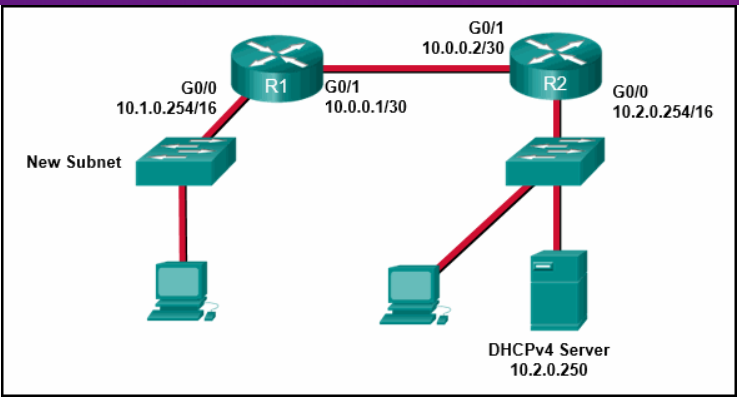
CCNA 2 v7 Switching Routing and Wireless Essentials-Version-Final-Answers-43
What two commands will allow hosts on the new subnet to receive addresses from the DHCP4 server? (Choose two.)
- R1(config-if)# ip helper-address 10.1.0.254
- R1(config)# interface G0/0
- R1(config-if)# ip helper-address 10.2.0.250
- R1(config)# interface G0/1
- R2(config-if)# ip helper-address 10.2.0.250
- R2(config)# interface G0/0
44. Refer to the exhibit. R1 has been configured as shown. However, PC1 is not able to receive an IPv4 address. What is the problem?
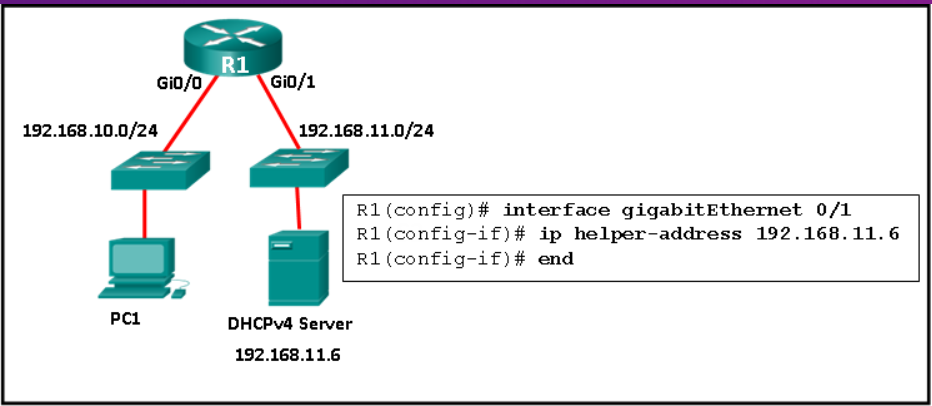
CCNA 2 v7 Switching Routing and Wireless Essentials-Version-Final-Answers-43
- The ip helper-address command was applied on the wrong interface.
- R1 is not configured as a DHCPv4 server.
- A DHCP server must be installed on the same LAN as the host that is receiving the IP address.
- The ip address dhcp command was not issued on the interface Gi0/1.
45. What two default wireless router settings can affect network security? (Choose two.)
- The SSID is broadcast.
- MAC address filtering is enabled.
- WEP encryption is enabled.
- The wireless channel is automatically selected.
- A well-known administrator password is set.
46. What is the common term given to SNMP log messages that are generated by network devices and sent to the SNMP server?
- traps
- acknowledgments
- auditing
- warnings
47. A network administrator is adding a new WLAN on a Cisco 3500 series WLC. Which tab should the administrator use to create a new VLAN interface to be used for the new WLAN?
- WIRELESS
- MANAGEMENT
- CONTROLLER
- WLANs
48. A network administrator is configuring a WLAN. Why would the administrator change the default DHCP IPv4 addresses on an AP?
- to restrict access to the WLAN by authorized, authenticated users only
- to monitor the operation of the wireless network
- to reduce outsiders intercepting data or accessing the wireless network by using a well-known address range
- to reduce the risk of interference by external devices such as microwave ovens
49. Which two functions are performed by a WLC when using split media access control (MAC)? (Choose two.)
- packet acknowledgments and retransmissions
- frame queuing and packet prioritization
- beacons and probe responses
- frame translation to other protocols
- association and re-association of roaming clients
50. On what switch ports should BPDU guard be enabled to enhance STP stability?
- all PortFast-enabled ports
- only ports that are elected as designated ports
- only ports that attach to a neighboring switch
- all trunk ports that are not root ports
51. Which network attack is mitigated by enabling BPDU guard?
- rogue switches on a network
- CAM table overflow attacks
- MAC address spoofing
- rogue DHCP servers on a network
52. Why is DHCP snooping required when using the Dynamic ARP Inspection feature?
- It relies on the settings of trusted and untrusted ports set by DHCP snooping.
- It uses the MAC address table to verify the default gateway IP address.
- It redirects ARP requests to the DHCP server for verification.
- It uses the MAC-address-to-IP-address binding database to validate an ARP packet.
53. Refer to the exhibit. Router R1 has an OSPF neighbor relationship with the ISP router over the 192.168.0.32 network. The 192.168.0.36 network link should serve as a backup when the OSPF link goes down. The floating static route command ip route 0.0.0.0 0.0.0.0 S0/0/1 100 was issued on R1 and now traffic is using the backup link even when the OSPF link is up and functioning. Which change should be made to the static route command so that traffic will only use the OSPF link when it is up?
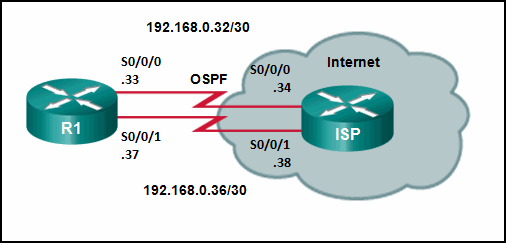

- Change the administrative distance to 120.
- Add the next hop neighbor address of 192.168.0.36.
- Change the destination network to 192.168.0.34.
- Change the administrative distance to 1.
54. Refer to the exhibit. What is the metric to forward a data packet with the IPv6 destination address 2001:DB8:ACAD:E:240:BFF:FED4:9DD2?


- 90
- 128
- 2170112
- 2681856
- 2682112
- 3193856
55. A network administrator is configuring a new Cisco switch for remote management access. Which three items must be configured on the switch for the task? (Choose three.)
- IP address
- VTP domain
- vty lines
- default VLAN
- default gateway
- loopback address
56. Refer to the exhibit. Which statement shown in the output allows router R1 to respond to stateless DHCPv6 requests?


- ipv6 nd other-config-flag
- prefix-delegation 2001:DB8:8::/48 00030001000E84244E70
- ipv6 dhcp server LAN1
- ipv6 unicast-routing
- dns-server 2001:DB8:8::8
57. Refer to the exhibit. A Layer 3 switch routes for three VLANs and connects to a router for Internet connectivity. Which two configurations would be applied to the switch? (Choose two.)
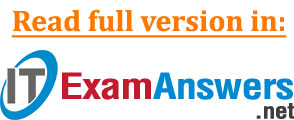
(config)# interface gigabitethernet1/1
(config-if)# switchport mode trunk
(config-if)# switchport mode trunk
(config)# interface gigabitethernet 1/1
(config-if)# no switchport
(config-if)# ip address 192.168.1.2 255.255.255.252
(config-if)# no switchport
(config-if)# ip address 192.168.1.2 255.255.255.252
(config)# interface vlan 1
(config-if)# ip address 192.168.1.2 255.255.255.0
(config-if)# no shutdown
(config-if)# ip address 192.168.1.2 255.255.255.0
(config-if)# no shutdown
(config)# interface fastethernet0/4
(config-if)# switchport mode trunk
(config-if)# switchport mode trunk
(config)# ip routing
58. A technician is troubleshooting a slow WLAN and decides to use the split-the-traffic approach. Which two parameters would have to be configured to do this? (Choose two.)
- Configure the 5 GHz band for streaming multimedia and time sensitive traffic.
- Configure the security mode to WPA Personal TKIP/AES for one network and WPA2 Personal AES for the other network
- Configure the 2.4 GHz band for basic internet traffic that is not time sensitive.
- Configure the security mode to WPA Personal TKIP/AES for both networks.
- Configure a common SSID for both split networks.
59. A company has just switched to a new ISP. The ISP has completed and checked the connection from its site to the company. However, employees at the company are not able to access the internet. What should be done or checked?
- Verify that the static route to the server is present in the routing table.
- Check the configuration on the floating static route and adjust the AD.
- Ensure that the old default route has been removed from the company edge routers.
- Create a floating static route to that network.
60. Which information does a switch use to populate the MAC address table?
- the destination MAC address and the incoming port
- the destination MAC address and the outgoing port
- the source and destination MAC addresses and the incoming port
- the source and destination MAC addresses and the outgoing port
- the source MAC address and the incoming port
- the source MAC address and the outgoing port
61. Refer to the exhibit. A network administrator is reviewing the configuration of switch S1. Which protocol has been implemented to group multiple physical ports into one logical link?
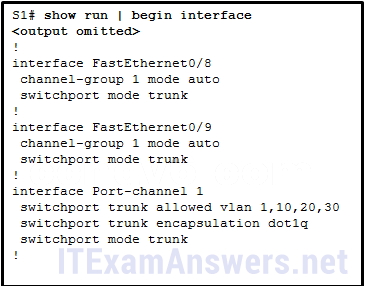

- PAgP
- DTP
- LACP
- STP
62. Which type of static route is configured with a greater administrative distance to provide a backup route to a route learned from a dynamic routing protocol?
- floating static route
- default static route
- summary static route
- standard static route
63. What action takes place when a frame entering a switch has a unicast destination MAC address appearing in the MAC address table?
- The switch updates the refresh timer for the entry.
- The switch forwards the frame out of the specified port.
- The switch purges the entire MAC address table.
- The switch replaces the old entry and uses the more current port.
64. The exhibit shows two PCs called PC A and PC B, two routes called R1 and R2, and two switches. PC A has the address 172.16.1.1/24 and is connected to a switch and into an interface on R1 that has the IP address 172.16.1.254. PC B has the address 172.16.2.1/24 and is connected to a switch that is connected to another interface on R1 with the IP address 172.16.2.254. The serial interface on R1 has the address 172.16.3.1 and is connected to the serial interface on R2 that has the address 172.16.3.2/24. R2 is connected to the internet cloud. Which command will create a static route on R2 in order to reach PC B?
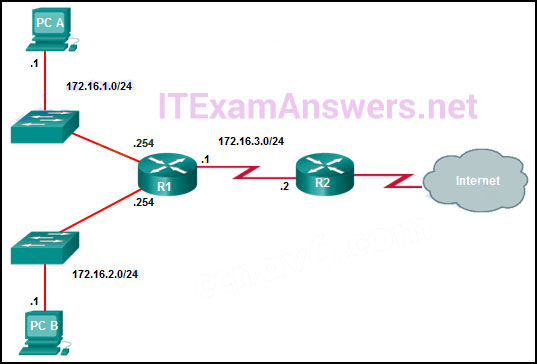

- R2(config)# ip route 172.16.2.1 255.255.255.0 172.16.3.1
- R2(config)# ip route 172.16.2.0 255.255.255.0 172.16.2.254
- R2(config)# ip route 172.16.2.0 255.255.255.0 172.16.3.1
- R2(config)# ip route 172.16.3.0 255.255.255.0 172.16.2.254
65. What protocol or technology allows data to transmit over redundant switch links?
- EtherChannel
- DTP
- STP
- VTP
66. Refer to the exhibit. Which three hosts will receive ARP requests from host A, assuming that port Fa0/4 on both switches is configured to carry traffic for multiple VLANs? (Choose three.)


- host B
- host C
- host D
- host E
- host F
- host G
67. Refer to the exhibit. The network administrator configures both switches as displayed. However, host C is unable to ping host D and host E is unable to ping host F. What action should the administrator take to enable this communication?
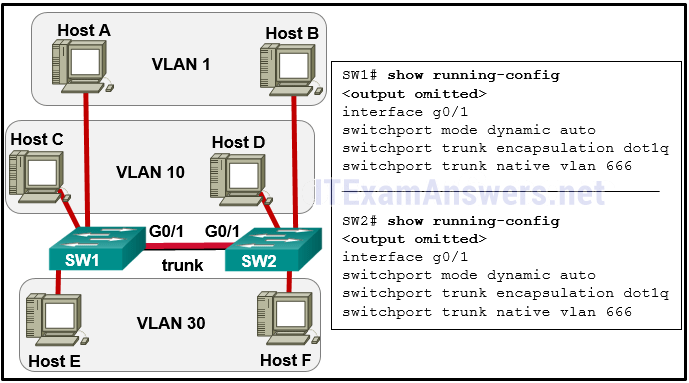

- Associate hosts A and B with VLAN 10 instead of VLAN 1.
- Configure either trunk port in the dynamic desirable mode.
- Include a router in the topology.
- Remove the native VLAN from the trunk.
- Add the switchport nonegotiate command to the configuration of SW2.
68. What is the effect of entering the shutdown configuration command on a switch?
- It enables BPDU guard on a specific port.
- It disables an unused port.
- It enables portfast on a specific switch interface.
- It disables DTP on a non-trunking interface.
69. What would be the primary reason an attacker would launch a MAC address overflow attack?
- so that the switch stops forwarding traffic
- so that legitimate hosts cannot obtain a MAC address
- so that the attacker can see frames that are destined for other hosts
- so that the attacker can execute arbitrary code on the switch
70. During the AAA process, when will authorization be implemented?
- Immediately after successful authentication against an AAA data source
- Immediately after AAA accounting and auditing receives detailed reports
- Immediately after an AAA client sends authentication information to a centralized server
- Immediately after the determination of which resources a user can access
71. A company security policy requires that all MAC addressing be dynamically learned and added to both the MAC address table and the running configuration on each switch. Which port security configuration will accomplish this?
- auto secure MAC addresses
- dynamic secure MAC addresses
- static secure MAC addresses
- sticky secure MAC addresses
72. Which three Wi-Fi standards operate in the 2.4GHz range of frequencies? (Choose three.)
- 802.11a
- 802.11b
- 802.11g
- 802.11n
- 802.11ac
73. To obtain an overview of the spanning tree status of a switched network, a network engineer issues the show spanning-tree command on a switch. Which two items of information will this command display? (Choose two.)
- The root bridge BID.
- The role of the ports in all VLANs.
- The status of native VLAN ports.
- The number of broadcasts received on each root port.
- The IP address of the management VLAN interface.
74. Refer to the exhibit. Which trunk link will not forward any traffic after the root bridge election process is complete?
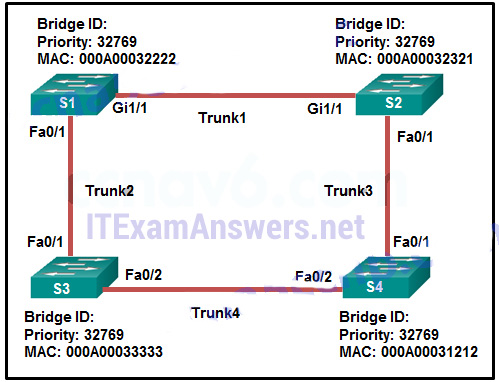

- Trunk1
- Trunk2
- Trunk3
- Trunk4
75. Which method of IPv6 prefix assignment relies on the prefix contained in RA messages?
- EUI-64
- SLAAC
- static
- stateful DHCPv6
76. Which two protocols are used to provide server-based AAA authentication? (Choose two.)
- 802.1x
- SSH
- SNMP
- TACACS+
- RADIUS
77. A network administrator is configuring a WLAN. Why would the administrator disable the broadcast feature for the SSID?
- to eliminate outsiders scanning for available SSIDs in the area
- to reduce the risk of interference by external devices such as microwave ovens
- to reduce the risk of unauthorized APs being added to the network
- to provide privacy and integrity to wireless traffic by using encryption
78. Which mitigation technique would prevent rogue servers from providing false IP configuration parameters to clients?
- implementing port security
- turning on DHCP snooping
- disabling CDP on edge ports
- implementing port-security on edge ports
79. A network administrator configures the port security feature on a switch. The security policy specifies that each access port should allow up to two MAC addresses. When the maximum number of MAC addresses is reached, a frame with the unknown source MAC address is dropped and a notification is sent to the syslog server. Which security violation mode should be configured for each access port?
- shutdown
- restrict
- warning
- protect
80. What protocol or technology defines a group of routers, one of them defined as active and another one as standby?
- EtherChannel
- VTP
- HSRP
- DTP
81. Refer to the exhibit. After attempting to enter the configuration that is shown in router RTA, an administrator receives an error and users on VLAN 20 report that they are unable to reach users on VLAN 30. What is causing the problem?
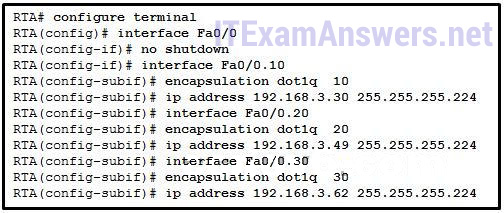

- There is no address on Fa0/0 to use as a default gateway.
- RTA is using the same subnet for VLAN 20 and VLAN 30.
- Dot1q does not support subinterfaces.
- The no shutdown command should have been issued on Fa0/0.20 and Fa0/0.30.
82. Which three pairs of trunking modes will establish a functional trunk link between two Cisco switches? (Choose three.)
- dynamic desirable – dynamic desirable
- dynamic desirable – trunk
- dynamic auto – dynamic auto
- access – dynamic auto
- dynamic desirable – dynamic auto
- access – trunk
83. A technician is configuring a router for a small company with multiple WLANs and doesn’t need the complexity of a dynamic routing protocol. What should be done or checked?
- Verify that there is not a default route in any of the edge router routing tables.
- Create static routes to all internal networks and a default route to the internet.
- Create extra static routes to the same location with an AD of 1.
- Check the statistics on the default route for oversaturation.
84. A company is deploying a wireless network in the distribution facility in a Boston suburb. The warehouse is quite large and it requires multiple access points to be used. Because some of the company devices still operate at 2.4GHz, the network administrator decides to deploy the 802.11g standard. Which channel assignments on the multiple access points will make sure that the wireless channels are not overlapping?
- channels 1, 5, and 9
- channels 1, 6, and 11
- channels 1, 7, and 13
- channels 2, 6, and 10
85. A network administrator of a small advertising company is configuring WLAN security by using the WPA2 PSK method. Which credential do office users need in order to connect their laptops to the WLAN?
- the company username and password through Active Directory service
- a key that matches the key on the AP
- a user passphrase
- a username and password configured on the AP
86. Refer to the exhibit. What are the possible port roles for ports A, B, C, and D in this RSTP-enabled network?
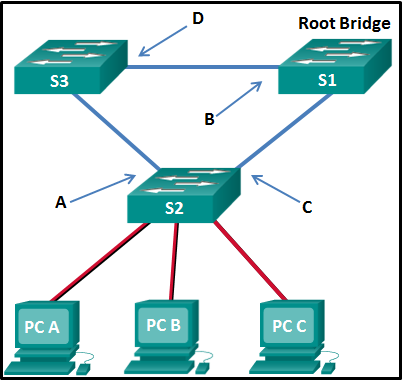
Modules 5 – 6: Redundant Networks Exam 33
- alternate, designated, root, root
- designated, alternate, root, root
- alternate, root, designated, root
- designated, root, alternate, root
87. Refer to the exhibit. Which static route would an IT technician enter to create a backup route to the 172.16.1.0 network that is only used if the primary RIP learned route fails?

- ip route 172.16.1.0 255.255.255.0 s0/0/0
- ip route 172.16.1.0 255.255.255.0 s0/0/0 121
- ip route 172.16.1.0 255.255.255.0 s0/0/0 111
- ip route 172.16.1.0 255.255.255.0 s0/0/0 91
88. What mitigation plan is best for thwarting a DoS attack that is creating a MAC address table overflow?
- Disable DTP.
- Disable STP.
- Enable port security.
- Place unused ports in an unused VLAN.
89. A network engineer is troubleshooting a newly deployed wireless network that is using the latest 802.11 standards. When users access high bandwidth services such as streaming video, the wireless network performance is poor. To improve performance the network engineer decides to configure a 5 Ghz frequency band SSID and train users to use that SSID for streaming media services. Why might this solution improve the wireless network performance for that type of service?
- Requiring the users to switch to the 5 GHz band for streaming media is inconvenient and will result in fewer users accessing these services.
- The 5 GHz band has more channels and is less crowded than the 2.4 GHz band, which makes it more suited to streaming multimedia.
- The 5 GHz band has a greater range and is therefore likely to be interference-free.
- The only users that can switch to the 5 GHz band will be those with the latest wireless NICs, which will reduce usage.
90. Which DHCPv4 message will a client send to accept an IPv4 address that is offered by a DHCP server?
- broadcast DHCPACK
- broadcast DHCPREQUEST
- unicast DHCPACK
- unicast DHCPREQUEST
91. Refer to the exhibit. Which destination MAC address is used when frames are sent from the workstation to the default gateway?
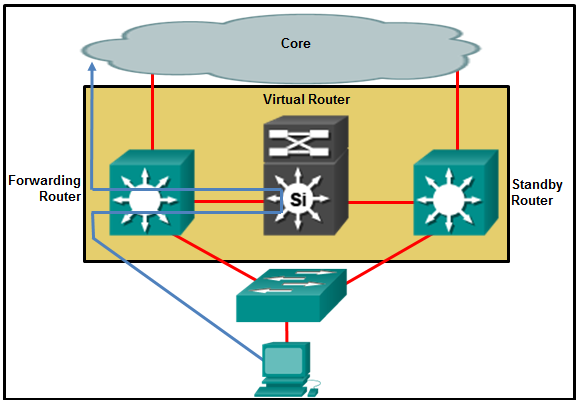
- MAC address of the virtual router
- MAC address of the standby router
- MAC addresses of both the forwarding and standby routers
- MAC address of the forwarding router
92. After a host has generated an IPv6 address by using the DHCPv6 or SLAAC process, how does the host verify that the address is unique and therefore usable?
- The host sends an ICMPv6 echo request message to the DHCPv6 or SLAAC-learned address and if no reply is returned, the address is considered unique.
- The host sends an ICMPv6 neighbor solicitation message to the DHCP or SLAAC-learned address and if no neighbor advertisement is returned, the address is considered unique.
- The host checks the local neighbor cache for the learned address and if the address is not cached, it it considered unique.
- The host sends an ARP broadcast to the local link and if no hosts send a reply, the address is considered unique.
93. Match the purpose with its DHCP message type. (Not all options are used.)
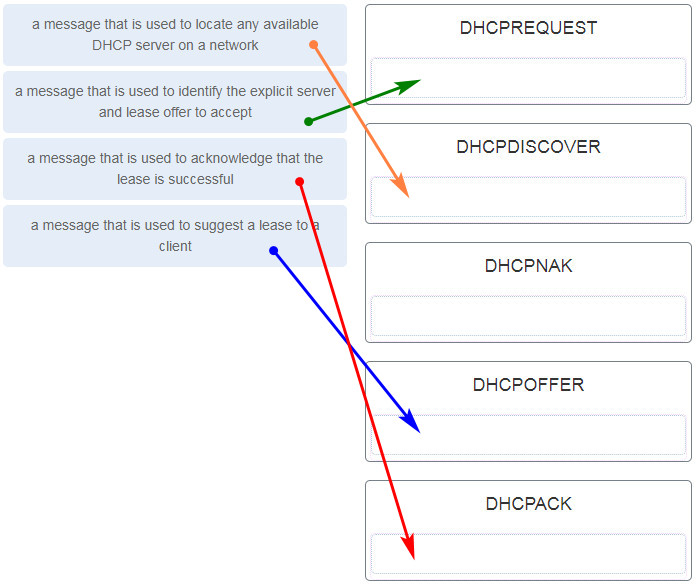

94. Which protocol adds security to remote connections?
- FTP
- HTTP
- NetBEUI
- POP
- SSH
95. Refer to the exhibit. A network administrator is verifying the configuration of inter-VLAN routing. Users complain that PC2 cannot communicate with PC1. Based on the output, what is the possible cause of the problem?
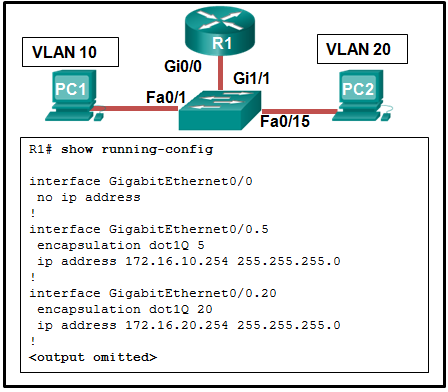
CCNA2 v7 Modules 1 – 4 Switching Concepts, VLANs, and InterVLAN Routing Exam Answers 44
- Gi0/0 is not configured as a trunk port.
- The command interface GigabitEthernet0/0.5 was entered incorrectly.
- There is no IP address configured on the interface Gi0/0.
- The no shutdown command is not entered on subinterfaces.
- The encapsulation dot1Q 5 command contains the wrong VLAN.
96. Refer to the exhibit. A network administrator is configuring inter-VLAN routing on a network. For now, only one VLAN is being used, but more will be added soon. What is the missing parameter that is shown as the highlighted question mark in the graphic?
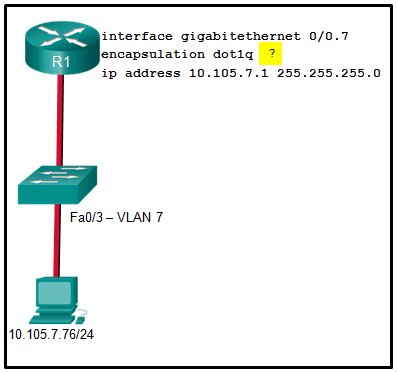
CCNA2 v7 Modules 1 – 4 Switching Concepts, VLANs, and InterVLAN Routing Exam Answers 74
- It identifies the subinterface.
- It identifies the VLAN number.
- It identifies the native VLAN number.
- It identifies the type of encapsulation that is used.
- It identifies the number of hosts that are allowed on the interface.
97. Match each DHCP message type with its description. (Not all options are used.)
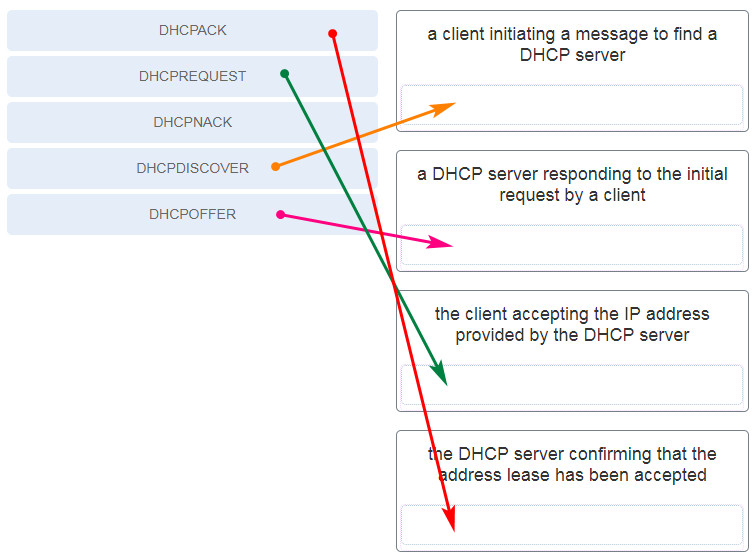
CCNA 2 v7 Modules 1 – 4: Switching Concepts, VLANs, and InterVLAN Routing Exam Answers
98. What network attack seeks to create a DoS for clients by preventing them from being able to obtain a DHCP lease?
- IP address spoofing
- DHCP starvation
- CAM table attack
- DHCP spoofing
99. Refer to the exhibit. If the IP addresses of the default gateway router and the DNS server are correct, what is the configuration problem?

- The DNS server and the default gateway router should be in the same subnet.
- The IP address of the default gateway router is not contained in the excluded address list.
- The default-router and dns-server commands need to be configured with subnet masks.
- The IP address of the DNS server is not contained in the excluded address list.
100. Refer to the exhibit. A network administrator has added a new subnet to the network and needs hosts on that subnet to receive IPv4 addresses from the DHCPv4 server. What two commands will allow hosts on the new subnet to receive addresses from the DHCP4 server? (Choose two.)
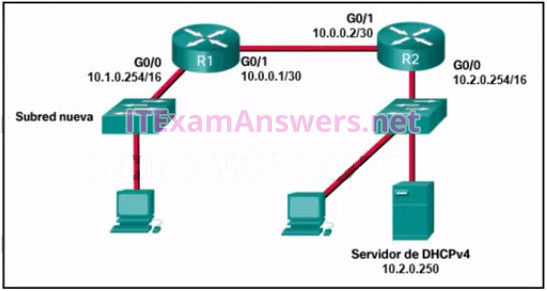
- R1(config-if)# ip helper-address 10.2.0.250
- R1(config)# interface G0/1
- R1(config)# interface G0/0
- R2(config-if)# ip helper-address 10.2.0.250
- R2(config)# interface G0/0
- R1(config-if)# ip helper-address 10.1.0.254
101. What protocol or technology uses source IP to destination IP as a load-balancing mechanism?
- VTP
- EtherChannel
- DTP
- STP
102. What protocol should be disabled to help mitigate VLAN attacks?
- CDP
- ARP
- STP
- DTP
103. What protocol or technology requires switches to be in server mode or client mode?
- EtherChannel
- STP
- VTP
- DTP
